 Are you thinking about setting up an e-commerce site or making goods or services available for sale online? If so, you may want to consider providing users with a currency conversion feature.
Are you thinking about setting up an e-commerce site or making goods or services available for sale online? If so, you may want to consider providing users with a currency conversion feature.
Currency conversion tools allow your prospects to translate foreign currency transactions into their local currency when purchasing products online. It also allows your visitors and customers to see the exact amount their card or PayPal account will be charged, expressed in their own home currency.
One great advantage of adding currency conversion is that it allows visitors to see and understand pricing in foreign countries in their own local currency, making it it easier for customers to calculate their costs and expenses.
If you are a WordPress user, it’s quite easy to add a currency converter to WordPress, allowing your prospective customers to quickly perform currency conversions to determine the cost of your products.
Currencyr – WordPress Currency Conversion Plugin
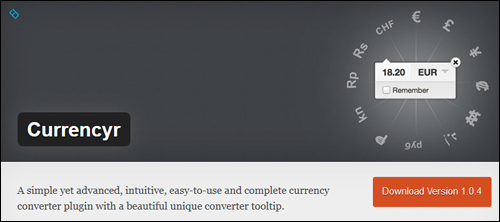
Currencyr is a simple, easy-to-use and complete currency converter plugin with a beautiful and unique converter tooltip. And, it’s free to install and use on your website or blog.
Some of the many features of this plugin include the following:
- Inline converter
- Supports various exchange rates providers, like Google, Open Exchange Rates & European Central Bank
- WP-Cron task scheduler enabled
- Widgetized currency table and converter
- Can be integrated with a number of online shopping plugins such as WooCommerce, WP-eCommerce & Easy Digital Downloads.
- Automatic local currency determination
- Translation support
Important: The Currencyr plugin requires your server to be running PHP 5.3.0 or later. Do not use this plugin if you are running an older version of PHP. Ask your web hosting company to check and upgrade your PHP.
***
You can install the plugin from your WordPress dashboard by typing in “currencyr” into the Plugins search field and clicking the “Install” button …
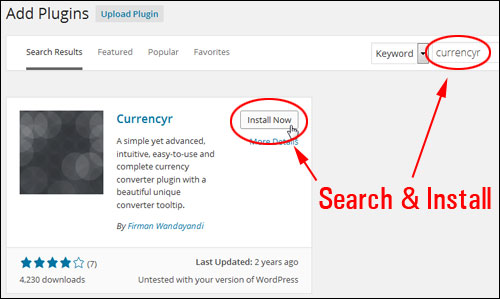
After installing and activating the plugin, you can configure the plugin’s settings by choosing Currencyr from your WP admin user menu …
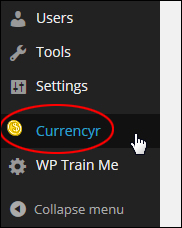
The plugin settings area provides several configuration options …
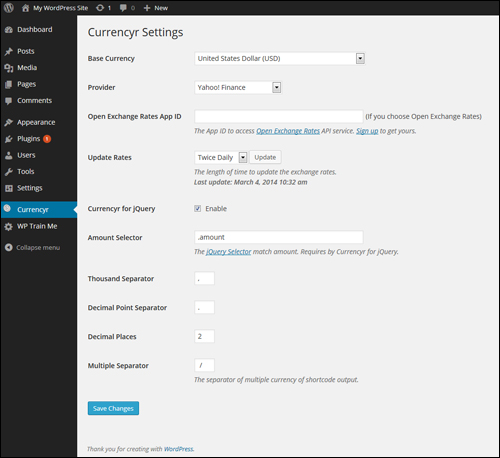
For example, you can choose a base currency from a dropdown menu. The default option is ’US Dollar’ …
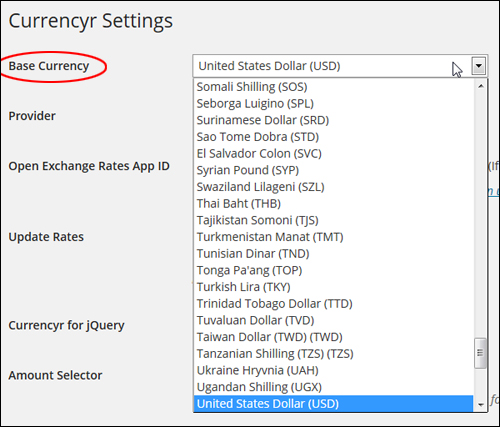
You can also specify which data provider you want to use from a drop-down menu. The default option is Yahoo Finance, but you can choose another option, such as European Central Bank, FoxRate, Google Finance or Open Exchange Rates …

Note: If you choose ‘Open Exchange Rates’ as your provider, you will need an API (Application Programming Interface) ID …

You can select how frequently you want the currency exchange rates to update by specifying an option from the Update Rates dropdown menu …

The Currencyr plugin uses jQuery, which allows web developers to add things like animation effects to web applications (e.g. WordPress plugins).
Unless you have a reason to edit the jQuery settings, leave these as they are …

Edit the rest of the plugin settings to suit your needs and don’t forget to click Save Changes when you have finished configuring this section …

Once you have configured your settings, you can start adding currency conversion to any of your WordPress pages using shortcodes.
See the ‘Additional Plugin Notes’ section below to learn how to use currency codes (e.g. USD, GBP, CAD, etc …) with this plugin.
Shortcodes
You can easily add currency conversion to WP pages, posts and widgets with no coding knowledge or skills using shortcodes.
Let’s take a look at some examples of currency shortcodes that you can add to posts and pages:
Let’s say that you sell a product on your site for a fixed amount (e.g. $175) in US Dollars (USD), and you would also like to show your conversion amount in British pounds (GBP) on your product sales page.
All you need to do is insert the shortcode below to your page content …

Note: You can also display pricing in dollars and cents (e.g. 155.25, 29.95, 295.75, etc …)
The example below shows how your shortcode will look after being inserted into your page or post …

After your post has been published, the currency conversion will appear like this …
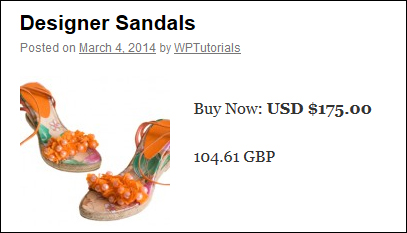
Using the above example, let’s also convert the same amount into different currencies.
To do this, use the shortcode below (add as many currency symbols as you want separated by vertical pipes) …

You can see how the above shortcode looks when inserted into a page …

After publishing the page or post, your currency conversion will then display like this …
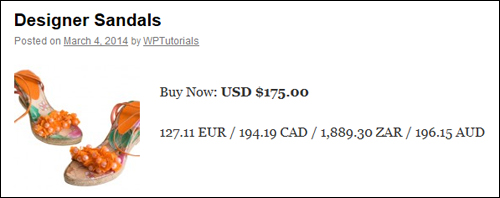
See the ‘Additional Plugin Notes’ section further below to learn how to change the currency separator symbol within this plugin.
Now, let’s say that you would like to select a different base currency than the one you have selected as your default.
For example, say you have set your default base currency as EUR and you have a section on your e-commerce pages targeted to customers from countries like Australia or Canada, you can change the base currency using the following shortcode …

The example below shows how the shortcode looks when added to a post …

After publishing the content, the converted currency will then appear like this …

How To Use The Plugin Widget
You can also insert a currency converter into your site’s sidebar area using a widget.
To add the currency converter to your sidebar menu, select Appearance > Widgets from your WP admin menu …
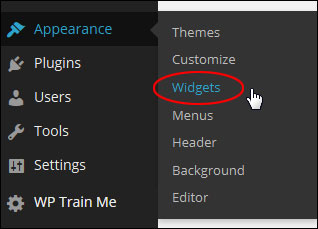
In the Widgets > Available Widgets area find the ‘Currencyr’ widget and add it to the Active Widgets area …
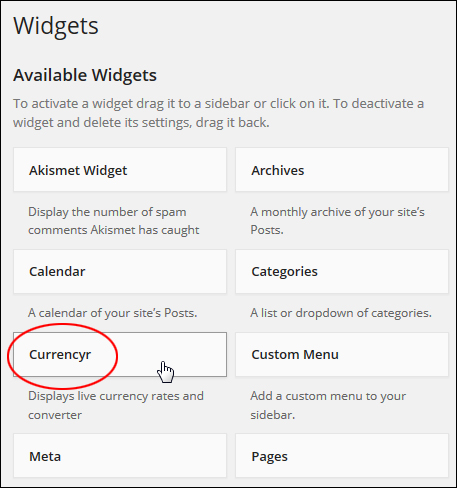
Configure the widget options as shown in the screenshot below (add currency codes separated by commas), and click ‘Save’ to update your settings …
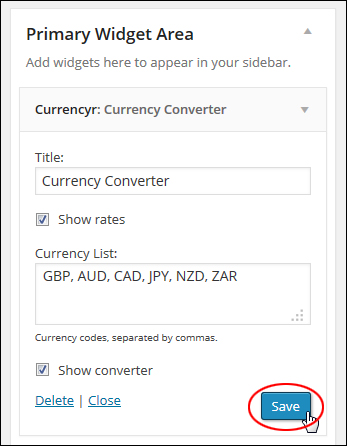
The currency conversion tool will now show on the sidebar menu with the settings you have selected …
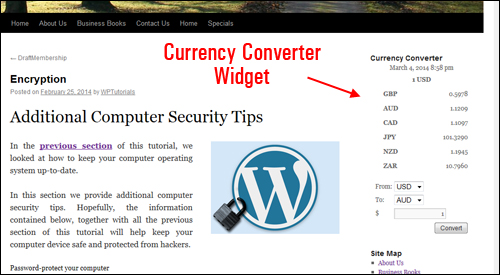
Additional Plugin Notes
This section contains additional information about using the Currencyr plugin.
Currency Separator
The Currencyr plugin lets you specify the symbol to display as the currency separator when using multiple currencies.
You can change the symbol in the ‘Multiple Separator’ settings section.
So, for example, entering the default symbol “/” (forward slash) …

Displays your currency values separated by a forward slash as you can see in the screenshot below …
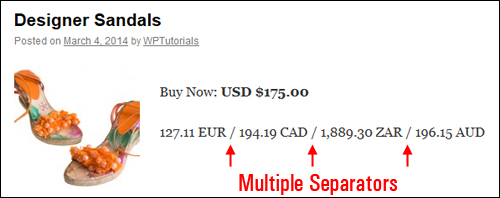
If you change this symbol and update your settings …

Your website visitors will see the new symbol display as the currency separator …
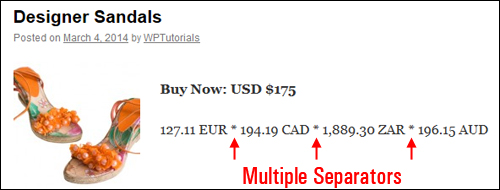
Integration With e-Commerce Platforms
As described earlier, the plugin can be integrated with various WP-compatible e-commerce plugins like WooCommerce, Shopp, and Easy Digital Downloads …
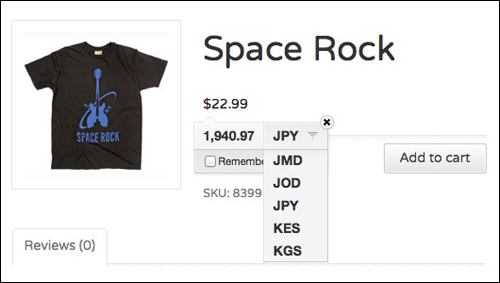
(image sourced from Currencyr plugin site)
And there you have it! Now you can go and easily add currency conversion to your e-commerce website.
To learn more about WordPress e-commerce plugins, see the tutorial below:
***
"I love the way your email series "Infinite Web Content Creation Training Series" is documented and presented. It is very absorbing and captivating. The links and tutorials are interesting and educational. This has motivated me to rewrite my content following the concepts I am learning from the email series." - Mani Raju, www.fortuneinewaste.com